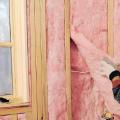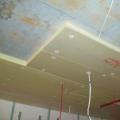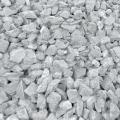How to insulate a wooden ceiling in a house? Proper insulation of a wooden ceiling in a private house
Floors in private houses are usually made of wood: beams are laid, and then they are lined with boards from below. If the house does not have a heated attic, the ceiling in the building must be insulated. And when installing equipment in the attic of a living space, it won’t hurt to lay something over the ceiling. After all, most, among other things, can also serve as excellent sound insulators.
Material selection
So, let's see how to insulate a house. And first, let's figure out what type of insulator is best to choose in a given case. Typically, floors in country buildings are insulated:
- mineral wool;
- expanded polystyrene;
- sawdust;
- expanded clay.
Advantages and disadvantages of mineral wool
This heat insulator is currently the most popular and is used most often in private homes. Its main advantages include:
- Low cost.
- Easy to install.
- High heat-retaining qualities.
- Insulating the ceiling in a house with this material can also improve the soundproofing properties of the floors.
- Durability.
- Non-flammability.
The disadvantages of this material include:
- The ability to accumulate moisture and lose some of its thermal insulation qualities.
- Not too high a degree of environmental cleanliness.
Expanded polystyrene
This material is also an excellent answer to the question of how to insulate a wooden ceiling in a house. It is a lightweight, environmentally friendly board. Although they are made using a slightly different technology, their appearance is very similar to the well-known polystyrene foam. They differ from the latter in that they practically do not crumble and retain heat much better. Expanded polystyrene lasts much longer than polystyrene foam. Unlike mineral wool, this material is not at all afraid of moisture. Its main advantage over basalt insulator is its smaller thickness with the same heat-retaining qualities.
Its disadvantages include only its rather high cost and flammability. In addition, it is strictly not recommended to use this material if there are rodents in the house. Mice simply love to make passages and holes in foamy materials.

Expanded clay
This material is also very often used to insulate a wooden ceiling in a private house. Expanded clay is a special porous granule made from clay. The material is very inexpensive and retains heat well. Its main advantage is that it can last much longer than any other insulation. Not afraid of expanded clay and water. In addition, it is very durable and fire resistant.

Sawdust
The main advantages of this bulk material are absolute environmental friendliness and low weight. Insulating the ceiling with sawdust is very inexpensive. At sawmills they sell this material for literally pennies, and sometimes even give it away for free. The disadvantages of sawdust include, first of all, a very high risk of fire. In addition, they may dry out or begin to rot. Like polystyrene foam, they can harbor mice or rats.

Insulation of a wooden ceiling in a private house with mineral wool
When insulating the ceiling from the attic side, this material is laid as follows:
- In a building under construction, the ceiling itself, made from edged boards, is placed on the beams below. If the house is old and there are already floors in the attic, a cellular frame should be installed on them.
- A vapor barrier is laid between the beams. You can use either polyethylene or foil material. The latter option is more expensive, but performs its function much better. In addition, foil can reflect heat back into the room. Therefore, such materials, in addition to everything else, are also capable of additionally retaining heat. A vapor barrier is installed on existing attic floors in old houses before installing the frame under the slabs.
- At the next stage, the mineral wool itself is installed. They put her to shame. That is, the step between the beams should be slightly less than the width of the slabs. This allows for the most effective insulation. You need to start laying the wool from the corner farthest from the door. To make it comfortable to walk on the floor, it is worth lining the attic with strips of plywood.
- A waterproofing layer is laid on top of the mineral wool if the attic is not intended to be insulated in the future. If the roof is waterproofed with film, this step can be skipped.
- Next, the finishing floor of the attic is filled.
In exactly the same way, insulation of a wooden ceiling in a brick or poured concrete one is carried out. If there is a chimney in the attic, the slabs are placed on it to a height of 40-50 cm and secured.
Installation from inside
Next, let's see how to insulate a wooden ceiling in a house with mineral wool from the living room side. Most often, the material in this case is installed simultaneously with the pre-assembled metal frame for drywall. The distance between its constituent profiles is usually 40 cm. Mineral wool slabs have a width of 50-120 cm. Therefore, installation is carried out using the accordion method. The cotton wool is simply slipped under the frame elements. In this case, the plates are installed close to each other. When performing this work, you should try not to wrinkle the material. Otherwise, the cotton wool will lose some of its performance characteristics.
Do-it-yourself ceiling insulation from the inside continues with the installation of a vapor barrier film. Next, the gypsum boards themselves are installed on the frame. In the event that suspended ceilings are not installed, the work is performed using a slightly different technology:
- The ceiling is first covered with a vapor barrier film. If there is no attic above, it is better to use a waterproofing membrane.
- Next, a wooden sheathing is placed on it. For its manufacture, bars with a cross section of 30*30 - 40*40 mm are used. In this case, the step between the frame elements is made so that the slabs lie sideways.
- At the next stage, mineral wool is inserted between the bars. If the sheathing was installed correctly, the slabs will hold up well just like that. However, in order to completely eliminate the risk of falling out, it is worth additionally securing them with special mushroom dowels.
- Next, it is stretched onto the frame. You need to nail it with slats at least three centimeters thick. This will provide an additional ventilation layer.
- At the next stage, the ceiling is usually sheathed with plywood and covered with ceiling tiles.
Installation of polystyrene foam
Now let's figure out how to insulate the ceiling in a wooden house using another modern material. Typically, expanded polystyrene is laid in the attic in the same way as mineral wool - between beams or in the sheathing. However, it is entirely possible to install it directly on the attic floors, if any, that is, without installing a frame. In this case, the base must be thoroughly cleaned of dirt and leveled. Then the work is done like this:
- Check to see if the floor boards have rotted or come loose.
- Lay a layer of vapor barrier. Fastening is done using staplers.
- From the corner farthest from the door, begin laying out the expanded polystyrene slabs. At the same time, make sure that the joints do not meet in a cross. That is, they perform staggered laying.
- The joints between the plates are sealed with polyurethane foam and additionally taped with construction tape.
- Since the slabs are a rather fragile material, they either put a board on top of them, or pour a 3-4 cm cement screed. In the first case, before laying polystyrene foam on the floors, you will need to fill several logs.
Using polystyrene foam from the inside
Insulation of a wooden ceiling in a private house in this case is carried out as follows:
- The ceiling is thoroughly cleaned of dirt, old plaster (if any), etc.
- After this it should be primed.
- Next, polystyrene foam boards are glued to the ceiling using foam glue. In this case, the material should also be additionally secured with “fungi”.
- A reinforcing mesh is glued on top of the slabs.
- Next, the ceiling is plastered.
Of course, you can install polystyrene foam in the same way as mineral wool, that is, in the sheathing. In this case, the ceiling is sheathed with plywood, clapboard or edged boards at the final stage.
We insulate the ceiling in a wooden house with expanded clay
In this case, the space between the floor beams is pre-covered with roofing felt. You can also use very thick plastic film. The waterproofing material must also cover the beams themselves. Seams on roofing felt are glued with bitumen mastic, on film - with tape. Along the perimeter of the attic, the waterproofing material must be raised to the height of the future backfill layer.
Next, the ceiling itself is insulated with expanded clay. Sometimes the roofing material is pre-coated with a clay solution. The thickness of the expanded clay layer is usually 12-16 cm. It is advisable to use a material that has different fractions of granules. In this case, the insulating layer will be denser and more even. Sometimes crushed foam is added to expanded clay to enhance the thermal insulation effect.
The heat insulator is covered with a waterproofing film on top. Next, a concrete screed 4-5 cm thick is installed. 20 days after pouring, you can begin finishing the floor.
Insulation with sawdust
For such material, cement is usually used as a binder. In order to prevent the appearance of rodents, you can also add a little lime to the sawdust. Rotting is prevented by using borax.
As with expanded clay insulation, the attic floors in this case are first covered with roofing felt or plastic film. You can also use sheet glassine.
The sawdust itself has the following requirements:
- They must be aged for at least a year.
- The material must be dry.
- It is not allowed to insulate the ceiling with sawdust, rotten or infested insects.
- It is best to use sawdust of the middle fraction.
After the attic floors have been prepared and waterproofed, they begin to actually prepare the insulating solution itself. To do this, for ten buckets of sawdust, take one bucket of cement and half a bucket of lime. In addition, dilute a glass of borax in a bucket of water and spray this solution from a watering can over the mixture. The amount of water depends on the moisture level of the sawdust. Usually you have to add 5-10 liters.

The chimney must be laid before installing this type of insulation. The wiring in the attic in this case is laid in special metal pipes. It is not necessary to make a screed over the sawdust insulation. The frozen mixture itself will be quite strong.
So, you now know how to insulate a wooden ceiling in a house. If the work will be done from the inside, use thinner polystyrene foam. When insulating from the attic side, it is better to use mineral wool. You can save money by using expanded clay or sawdust.


 Construction materials and list of works
Construction materials and list of works Proper insulation of a wooden ceiling in a private house
Proper insulation of a wooden ceiling in a private house What types of crushed stone are there?
What types of crushed stone are there?